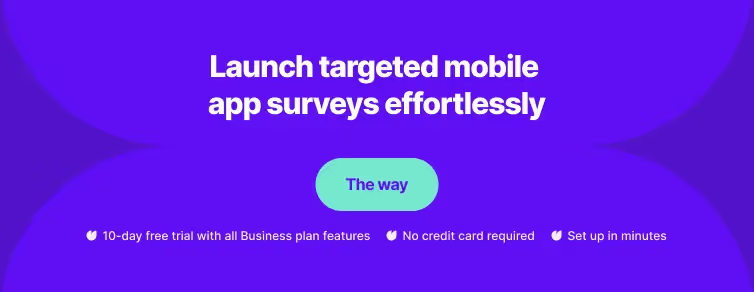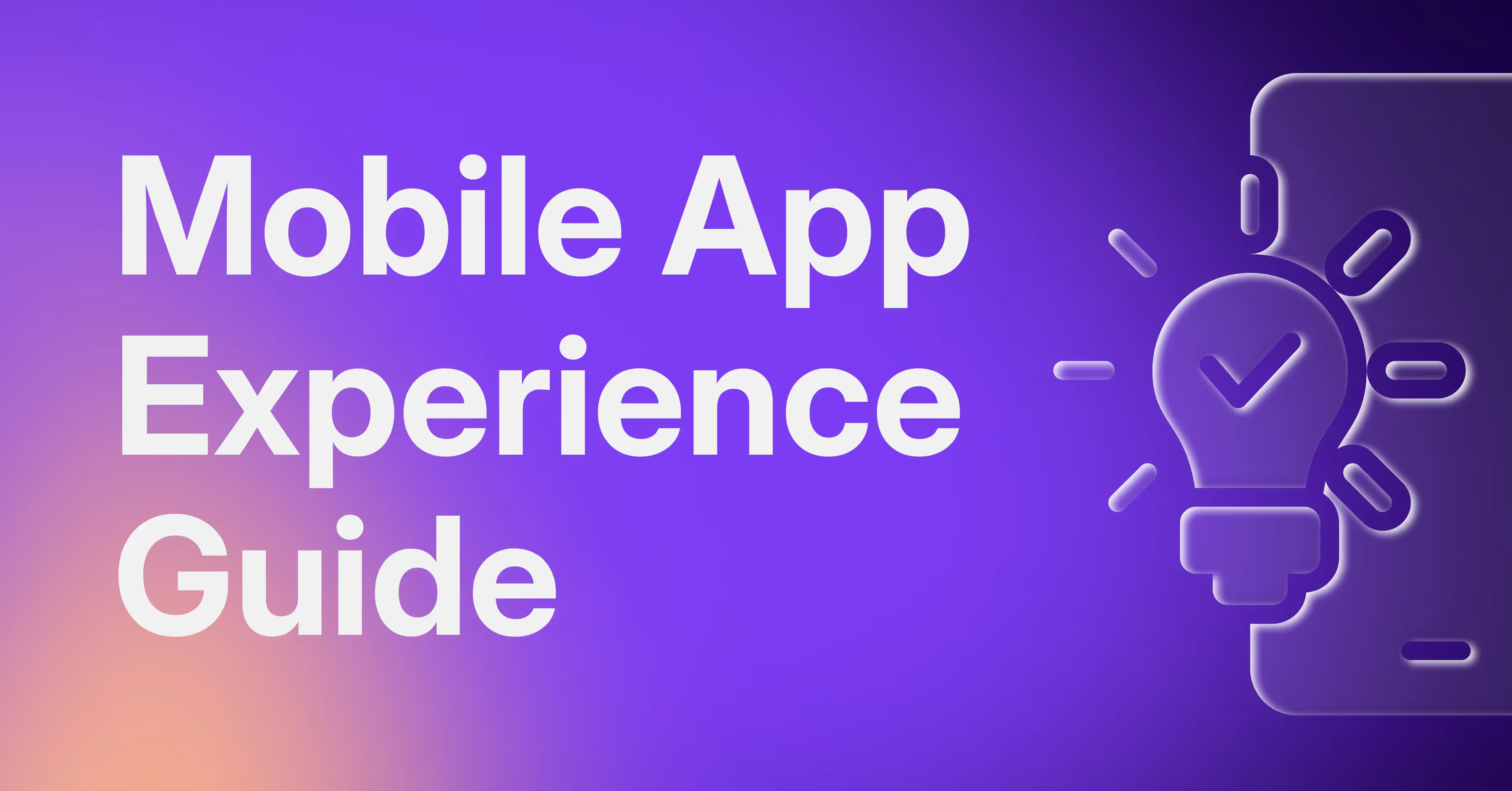- User-Centric Optimization: Prioritize user goals and tailor mobile content and CTAs to their needs for quick, accessible information and services, directly impacting conversions and thus, your app experience.
- Leverage Mobile Surveys: Run in-app surveys to gather direct user feedback, enhancing UX and CRO by understanding user satisfaction, issues, and expectations.
- In-Depth Behavioral Analysis: Utilize analytics, track key mobile metrics like CTR, bounce rates, conversion rates, and time on page to identify user behavior and optimize the mobile experience.
- Technical Excellence and Content Strategy: Ensure technical soundness with SEO, cross-device compatibility, and AMP implementation, and create mobile-optimized content that is concise, visually engaging, and tailored for on-the-go users.
- Align Strategy with Business Goals: Develop a CRO mobile strategy that aligns with specific, measurable, achievable, relevant, and time-bound business objectives to effectively track and adapt to user engagement and conversion data.

Understanding what prompts users to convert is at the core of CRO for mobile.
At the end, you want to create a superb mobile experience that attracts and encourages your mobile visitors to take the desired action. Optimizing the mobile conversion path—from initial engagement to post-conversion user retention strategies—may be the answer.
Read on to learn how to do it, step by step.
Understanding CRO mobile fundamentals
CRO mobile is a critical strategy that addresses the unique challenges and opportunities of mobile users. As consumers increasingly turn to smartphones and tablets for their online activities, it’s essential for businesses to optimize their mobile presence.
Effective CRO for mobile requires a tailored approach that considers factors such as the limited screen size, touch interfaces, and varying connectivity qualities.
Through rigorous testing and analyzing how users behave, businesses can identify areas for improvement, leading to enhanced user experiences and higher conversion rates on mobile devices.
What is mobile Conversion Rate Optimization (CRO)?
Mobile Conversion Rate Optimization (CRO) is the practice of enhancing your mobile website or app to increase the percentage of users who perform a desired action. These actions can range from purchasing to signing up for a newsletter.
In essence, CRO mobile is about understanding what drives, stops, and persuades your users.
Why is mobile device user experience important?
User Experience (UX) on mobile is critical because it directly impacts a user’s perception of your brand and their likelihood to convert. A positive mobile UX is seamless and intuitive, allowing users to navigate easily and complete actions.
Key elements in mobile app UX include responsiveness, speed, and accessibility. Prioritizing UX in your mobile strategy is non-negotiable if you aim to maintain competitiveness and drive conversions.
CRO mobile strategy development
To set the stage for a successful CRO on mobile, you need a strategy that recognizes distinct user behavior on mobile devices and aligns with your business goals.
Identify the goals of your mobile users
Understanding your mobile users' goals is your first step in developing a CRO mobile strategy.
Mobile users often seek quick, easily accessible information or services, so tailor your strategy to deliver exactly that. Here's how you might achieve this:
- Conduct user research to uncover what mobile users accomplish on your site.
- Analyze data from mobile user interactions to identify common conversion pathways.
- Ensure your mobile content and calls-to-action (CTAs) meet these user goals.
Align business objectives and CRO mobile
Aligning your CRO mobile strategy with your business objectives requires a clear roadmap. Here are steps to align the two:
- Define specific mobile-related objectives that support your overarching business goals.
- Measure user behavior and conversion data against these objectives.
- Ensure that mobile optimizations are achievable and realistic within your resource constraints.
- Verify that every mobile experience change is relevant to the user's needs and your business goals.
- Set time-bound milestones to track progress and adapt your strategy as needed.
How should you analyze user behavior?
First, you need to understand how users interact with your mobile website or application. A thorough analysis of mobile user behavior helps identify optimization opportunities for enhancing the user experience and ultimately increasing conversion rates.
Leverage user feedback and surveys
Feedback and surveys provide direct insight into user satisfaction. They can uncover issues that are not visible through analytics alone.
Collecting direct feedback from users through surveys can provide actionable insights into their experiences and expectations. It allows you to pinpoint improvement areas and understand what aspects are performing well.
Popular types of surveys
Net Promoter Score (NPS) surveys ask users how likely they are to recommend your service, providing a clear measure of long-term user satisfaction and loyalty.
User Satisfaction (CSAT) surveys measure users' satisfaction with your product or service after interacting with them.
Feature prioritization surveys gather ideas on what users want next and may help design your product roadmap accordingly.
Best distribution channels
Embedding surveys in your mobile app ensures you reach users in the right context.
Alternatively, embedding surveys in email can capture users' thoughts post-interaction.
Social media platforms also offer tools for creating and sharing surveys, tapping into a broader audience.
Online survey best practices
- Timing is crucial; ask for customer feedback after meaningful interactions, such as a purchase or customer service experience.
- Never disrupt user experience with surveys.
- Keep surveys short and focused to encourage completion.
- Create clear and unbiased questions to collect reliable data.
Utilizing user feedback and surveys is essential for optimizing the mobile experience. It helps identify what works, what doesn't, and what users expect, leading to informed decisions that can boost conversions.
Use mobile analytics data
Understand click-through rates (CTR)
Click-through rates measure the percentage of users who click on a link or call to action (CTA) after seeing it. This metric is crucial because a low CTR could indicate that your content or offers are not compelling enough to encourage user engagement.
Examine bounce rates
Bounce rate is the percentage of visitors who navigate away from the site after viewing only one page. It's important because it suggests whether your content meets users' expectations and if your landing pages are effectively designed to keep users interested.
Track conversion rates
Conversion rate is the percentage of users who take a desired action, such as making a purchase or signing up for a newsletter. This is a direct indicator of CRO success and tells you if your mobile platform is effectively persuading users to complete goals.
Analyze time on page
Time on page helps you understand how long users engage with your content. Longer engagement can be a sign of content relevance and interest, which can lead to higher conversion rates.
Review page load speed
Page Load Speed affects user experience and can influence bounce rates and conversions. Users typically prefer fast-loading pages, and slow speeds can deter them from completing a conversion.
Gauge active users
Active Users are individuals who have engaged with your app or website over a certain period of time. This metric is segmented into daily active users (DAU) and monthly active users (MAU), providing insight into the regularity and loyalty of your audience.
Tracking fluctuations in this metric can help you understand the long-term trends in user engagement and the effectiveness of your mobile strategies.
Monitor user retention
User Retention refers to the ability of a mobile app or website to retain users over time. It is usually expressed as a percentage indicating how many users return to the app or site after their first visit.

➡️ Read how Taxfix boosts retention through content relevancy and precise targeting built upon mobile in-app surveys.
High retention rates indicate a valuable and sticky user experience, while low retention can signal that improvements are needed to keep users coming back.
Conduct A/B testing on mobile
A/B testing is a powerful method for making data-driven decisions in mobile CRO. Here's a concise approach to conducting A/B tests:
- Identify a single variable, such as a button color or call-to-action wording.
- Create two versions (A and B), one with the original element and the other with a modified one.
- Test both versions with segments of your mobile audience.
- Analyze results to determine which version performs better regarding user engagement and conversion rates.
Remember, A/B testing should be an ongoing process to refine and improve the mobile user experience continuously.
Design and UX for mobile CRO
Effective mobile CRO hinges on a balance between a visually appealing design and a frictionless user experience. Your role is to ensure users engage with your app and take the desired actions.
Principles of mobile app-friendly design
Your design should cater to the limitations and advantages of smaller screens. The text should be readable without zooming, and buttons—large enough to be tapped easily.
Use white space judiciously to prevent a cluttered interface and quickly prioritize content that fulfills user needs.
Create intuitive navigation
Navigation on mobile must be immediately understandable. A hamburger menu is a space-saving solution, but consider using tab bars for critical sections of your app to keep them accessible. Ensure the user can always easily return to the home page or access search and customer support.
Optimize mobile page speed
Page load speed is critical—aim for a load time of under 3 seconds. Optimize images with appropriate resolutions, minimize HTTP requests, and leverage browser caching. A fast load time improves user experience and contributes heavily to retention and conversion.
Employ responsive design techniques
Responsive design is non-negotiable. Your site or app should seamlessly adjust to any device's screen size. Employ fluid grid layouts, flexible images, and media queries in your CSS to ensure a consistent and functional experience regardless of the device used.

Mobile conversion path optimization
While focusing on mobile conversion path optimization, you address the critical touchpoints influencing user decisions. This way, you can significantly lift your mobile conversion rates.
Simplify the checkout process
Your mobile checkout process should be as straightforward as possible.
Minimize the number of steps to completion and offer multiple payment options to accommodate user preferences.
Ensure that the next step is always clear, and consider integrating one-click purchasing if security allows.
Optimize forms for mobile device users
Forms on mobile require a design that respects the user's need for speed and convenience. Use input type detection to bring up the correct keypad and leverage automatic location detection for filling out address fields. Fields should also be large enough to interact with on a small screen without causing frustration.
Improve call-to-action (CTA) buttons
CTA buttons must be highly visible and placed intuitively within the mobile interface to prompt action.
Use bold colors that stand out from the background, and ensure buttons are of a size that's both finger-friendly for tapping and spaced to prevent accidental clicks.
The language used should create a sense of urgency or benefit, compelling the user to take action.
Technical considerations for mobile CRO
Technical aspects are crucial when optimizing your mobile conversion rates to ensure the user experience is seamless and conducive to conversion.
The following subsections provide key strategies you need to employ.
Address mobile SEO
For mobile SEO, it's imperative to structure content and page elements to favor mobile indexing. This includes using responsive design, optimizing meta tags, and ensuring search engines can easily crawl content.
- Responsive Design: Make certain your site adjusts the content layout to different screen sizes.
- Meta Tags Optimization: Utilize the meta title and description tags effectively to improve visibility.
- Site Speed: Improve load times by compressing images and reducing server response time.
Provide cross-device compatibility
Your platform's ability to provide a consistent experience across various devices is crucial.
To ensure cross-device compatibility:
- Test your site on a variety of devices and browsers.
- Apply fluid grids and flexible images to accommodate different screen sizes.
- Use CSS media queries to apply different styles based on device characteristics.
Implement accelerated mobile pages (AMP)
By implementing Accelerated Mobile Pages (AMP), your site can achieve faster loading times. AMP strips down the code and utilizes a CDN to cache and deliver content.
- Faster load times: AMP enables pages to load almost instantaneously, which improves engagement.
- AMP cache: Google's AMP cache can be leveraged for faster content delivery without compromising functionality.
Content strategy for mobile
When developing content for mobile users, you must ensure that it is easily digestible, visually engaging, and tailored to meet users' needs on the move.
Adjust content for mobile visitors
Your content should be concise and to the point. Mobile screens are smaller, so large blocks of text can overwhelm users or cause them to lose interest. Use bullet points to break down information:
- Brief paragraphs: 2-3 sentences each.
- Headings and subheadings: Clearly structure your content.
- Bullet points and lists: Present information in a way that's quick to scan.
Use visuals effectively on mobile devices
Visual content is crucial on mobile. It needs to be:
- Optimized for speed: Images should load quickly.
- Responsive: Visuals must be viewable on devices with varying screen sizes.
- Incorporate visuals that complement and reinforce your textual content without dominating the screen space.
Tailor messaging for mobile users
Messaging for mobile should immediately grab attention:
- Clear call-to-actions (CTAs): Make them prominent and easy to tap.
- Relevant information: Ensure that your content provides immediate value, addressing the needs of mobile users efficiently.
Retention and post-conversion strategies
After securing a conversion, your focus should shift to strategies that turn one-time mobile users into loyal customers.
Develop mobile device users engagement programs
Design mobile engagement programs with exclusive benefits to maintain customer interest and encourage repeat interactions. Tailoring promotions to user behavior and preferences gleaned from data analytics can boost the effectiveness of the engagement program. For example, you might implement:
- Loyalty rewards: Offer points for each purchase that can be redeemed for discounts or special offers.
- Personalized content: Deliver customized recommendations based on past purchases or browsing behavior.
Enhance post-purchase experience on mobile
The post-purchase phase is critical for retention. Ensure your mobile experience includes:
- Seamless transactional communications: Confirmations and receipts should be clear, easy to find, and optimized for mobile screens.
- Customer support access: Provide easy access to help and support, favorably through a mobile-optimized chat or a simple support ticket system.
By implementing these strategies, you ensure that your customers' mobile experience continues to satisfy, encouraging them to return to your app or mobile site.
Improve mobile conversion rates with Survicate
The path to boosting mobile conversions is paved with user-centric optimizations and data-driven decisions.
Optimizing mobile experiences for better conversion rates is an ongoing challenge that requires a deep understanding of user behavior and a commitment to continuous improvement. The main pillar of any successful CRO strategy is employing real user feedback to make informed decisions.
This is where Survicate steps in as an invaluable tool.
Survicate excels in capturing user insights through targeted surveys, allowing you to gather authentic feedback and act on it promptly.
With features like customizable survey templates, easy integration, and in-depth analytics, Survicate empowers you to pinpoint exactly what resonates with your mobile audience and what needs refinement.
Survicate offers the tools to gather the necessary user feedback that can transform your mobile strategy and enhance your conversion rates.
Interested in seeing how Survicate can benefit your business? Sign up for the 10-day free trial offering all the Business Plan features and start making your mobile experience a conversion powerhouse today.
You might also be interested in:
- Boost Your In-App Purchases and Revenue in 2024
- Mobile App Surveys: Questions, Templates, and Tips for 5-Star Ratings
- Mobile App KPIs: How to Measure App Performance in 2024
CRO mobile FAQs
This section addresses common questions about enhancing your mobile website's conversion rate, focusing on practical strategies, key metrics, and user experience.
How can conversion rate optimization be utilized on mobile platforms?
CRO on mobile platforms involves tailoring the design, content, and functionality specifically for mobile users. Your goal is to streamline the mobile experience to facilitate a smoother journey from visitor to customer.
What are the best practices for CRO on mobile websites?
To optimize conversion rates on mobile websites, you should ensure fast loading times, simplify navigation, and employ responsive design. A/B testing different elements can also inform you of what changes positively affect user behavior.
What metrics are critical for measuring the success of mobile CRO strategies?
Critical metrics include mobile conversion rate, bounce rate, average page load time, and the percentage of mobile traffic. These metrics reflect user engagement and your mobile site's effectiveness in driving conversions.
How does mobile user experience impact CRO?
A positive mobile user experience, ensured by intuitive interfaces and accessible design, directly impacts CRO by reducing friction points that might otherwise deter conversions. User satisfaction on mobile is paramount to conversion success.
Can you identify common pitfalls when implementing CRO on mobile sites?
Common pitfalls include ignoring mobile-specific user behavior, overloading with content, and not considering the diversity of mobile devices. Avoid these mistakes to ensure that CRO efforts yield the desired results on your mobile site.
What tools and technologies are recommended for effective mobile CRO analysis?
For effective mobile CRO analysis, utilize tools such as Google Analytics for traffic and user behavior insights and platforms like Optimizely for A/B testing. Heatmapping tools can also reveal how users interact with your mobile site.















